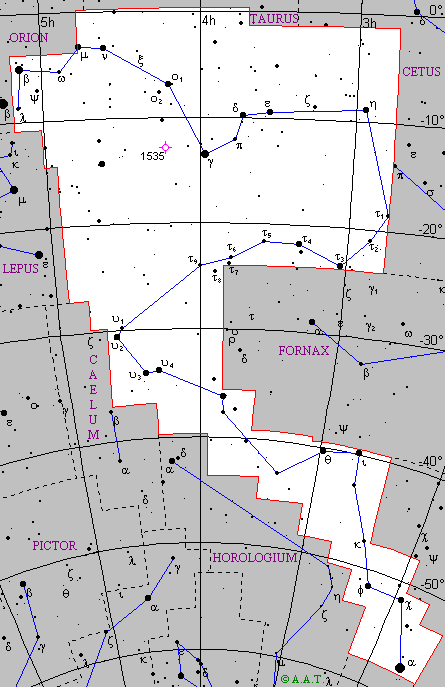 |
 |
| English name | Eridanus | ||||
|---|---|---|---|---|---|
| Major stars | alpha Eridani | Achernar | magn. 0,5 | RA: 01h 37m 42.90s | Dec: -57° 14' 12.0" |
| beta Eridani | Cursa | magn. 2,9 | RA: 05h 07m 50.98s | Dec: -05° 05' 11.0" | |
| gamma Eridani | Zaurak | magn. 3,2 | RA: 03h 58m 01.76s | Dec: -13° 30' 30.4" | |
| theta Eridani | Acamar | magn. 3,4 | RA: 02h 58m 15.70s | Dec: -40° 18' 17.0" | |
| Description | Sixth constellation of the sky in order of dimensions, Eridanus is licked up by equator in its most northern zone (where it confines with Orion and Taurus), and then it stretches toward south for almost sixty degrees of declination. In spite of its extension, Eridanus contains few bright stars. Among all, remarkable is Achernar ("river mouth", in Arab), a white-blue star which with its magnitude 0,5 is placed at the ninth place of the brightest stars. There is, then, an interesting triple star: it is omicron2 Eridani, also called Keid. The principal star, of fourth magnitude, is a yellow dwarf similar to our Sun; small telescopes reveal the presence of a companion, a white dwarf of tenth magnitude; with a little greater telescopes, finally, you can see a third component, a red dwarf of eleventh magnitude. With modest instruments you succeed in observing a beautiful planetary nebula, that appears as a bluish disk of magnitude 9: it is NGC 1535, which is in the northern region of the constellation. |
||||
| Mythology and history | Anciently they thought that a big river directly flowed into the Ocean Sea which embraced all the emerged earths: such river was called Eridanus. The river Eridanus is mentioned in the story of Phaethon, the son of Helium, god of the Sun, which had the task to conduct every day the cart of the Sun through the sky. Phaethon asked the father to drive the solar coach for one day: Helium, though reluctant, granted this wish. But the inexpert young didn't succeed in controlling the divine horses, which went away from the usual way. The run of Phaethon through the sky is broadly described by Ovid in the Metamorphoses (book II, vv. 1-332). The cart of the Sun went and warmed Ursa Maior, which in vain looked for refreshment in the sea, with his heat it woke up the sleeping Draco, it made Bootes run away perturbed; and when it came near the constellation of Scorpius, Phaethon feared its nippers and its poisonous tail, and he let the reins fall. Therefore the horses directed their steps towards the lower part and the Earth was parched: it was so that Libya became a desert, the skin of the Ethiopians became black and many seas were dried up. To put an end to such disasters, Zeus struck Phaethon with his thunderbolt, making him fall into Eridanus, where he died. |
||||
 Back to constellations page.
Back to constellations page.